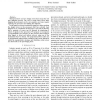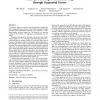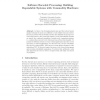114 search results - page 6 / 23 » Using likely program invariants to detect hardware errors |
DFT
1999
IEEE
13 years 11 months ago
1999
IEEE
The paper describes a systematic approach for automatically introducing data and code redundancy into an existing program written using a high-level language. The transformations ...
ICCD
2006
IEEE
14 years 4 months ago
2006
IEEE
— Microprocessors can have design errors that escape the test and validation process. The cost to rectify these errors after shipping the processors can be very expensive as it m...
SIGSOFT
2008
ACM
14 years 8 months ago
2008
ACM
Runtime monitoring allows programmers to validate, for instance, the proper use of application interfaces. Given a property specification, a runtime monitor tracks appropriate run...
ASPLOS
2011
ACM
12 years 11 months ago
2011
ACM
Concurrency bugs are caused by non-deterministic interleavings between shared memory accesses. Their effects propagate through data and control dependences until they cause softwa...
SAFECOMP
2007
Springer
14 years 1 months ago
2007
Springer
In future, the decreasing feature size and the reduced power supply will make it much more difficult to built reliable microprocessors. Economic pressure will most likely result in...



